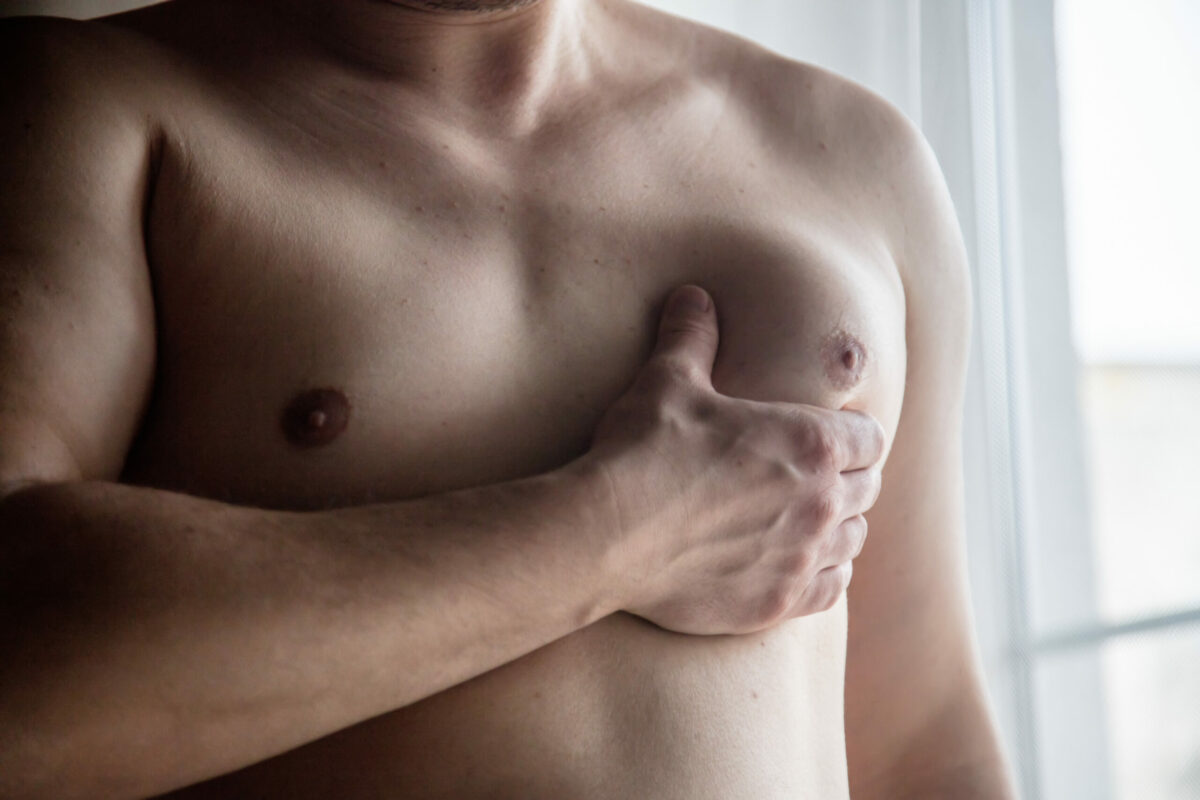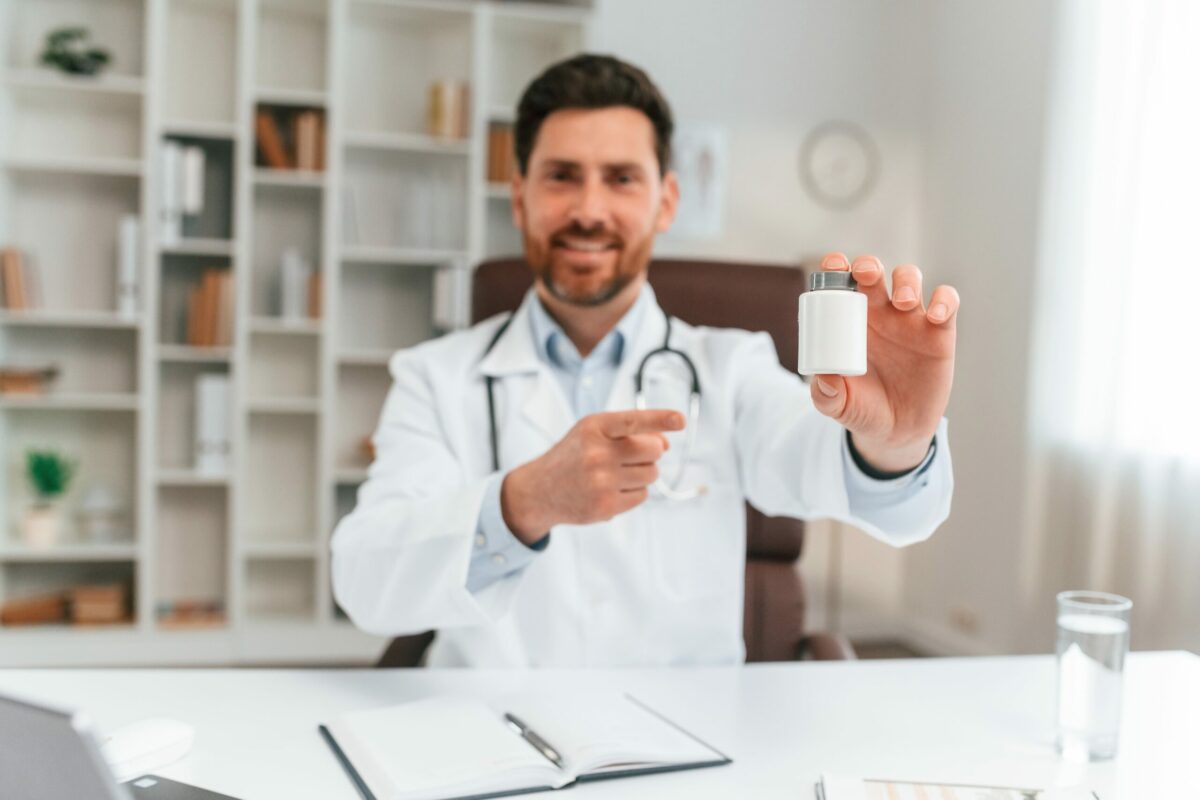An increase in the breast gland tissue amount in men or boys is a health condition called gynecomastia (also known as enlarged breasts in men). In most cases, it occurs due to an imbalance of hormones (such as Estrogen and Testosterone). This condition may affect one or both breasts (sometimes unevenly). In addition, this condition may be mistaken for pseudogynecomastia, which is a condition that causes enlarged breasts due to an increase in fat but not gland tissue.
Commonly, gynecomastia occurs in boys during puberty and older people due to natural hormonal changes but it may happen due to other causes as well. In most cases, this condition does not cause serious health problems but it is difficult to overcome the disease. Those who have gynecomastia may experience breast pain and may feel embarrassed.
While gynecomastia may go away on its own, sometimes it requires treatment that involves medications and surgery.
Symptoms
These include:
- Breast tenderness or pain (especially in teenagers)
- Increased nipple sensitivity
- Swollen breast tissue
Immediately contact your healthcare professional if any of the following symptoms happen. Examples include pain, swelling, or tenderness of the breasts, nipple discharge, a hard lump, or dimpled breast skin.
Causes
Men and people assigned to males at birth (AMAB) primarily produce the sex hormone Testosterone. However, they also produce Estrogen but in small amounts. This condition usually happens when the Testosterone amount drops significantly compared with Estrogen. These hormonal changes are often caused by health conditions that reduce Testosterone production or block its effect or due to diseases that increase Estrogen production. Check below some things that may lead to gynecomastia:
Natural Hormone Changes
Estrogen and Testosterone help control sex traits and other body processes including body hair and muscle mass but for breast growth is responsible Estrogen. Commonly, an imbalance of Estrogen with Testosterone causes gynecomastia.
- Infants – More than 50% of male babies are born with enlarged breast tissue due to Estrogen effects during pregnancy. However, swollen breasts disappear within a few weeks after birth.
- Puberty – Hormonal changes that occur during puberty may cause this condition. In most cases, swollen breast tissue goes away within 6 months to 2 years without treatment.
- Adults – Approximately 24% to 65% of men aged between 50 and 80 years old have gynecomastia. Mostly, adults with this condition do not experience any symptoms.
Medicines
Check below some medications that may cause gynecomastia:
- Anti-androgens (this group of medicines is prescribed by doctors to treat enlarged prostate gland and prostate cancer). These include Finasteride, Flutamide, and Spironolactone.
- Anabolic steroids and androgens are used to treat delayed puberty and muscle loss from other health conditions.
- Antiretroviral medications (such as Efavirenz)
ADHD medicines that contain Amphetamines (such as Adderall) - Anti-anxiety medicines (such as Diazepam)
- Tricyclic antidepressants
- Certain antibiotics
- Opioids (a group of medicines used to treat severe pain)
- Ulcer medicines include over-the-counter (OTC) medications such as Cimeditine and Omeprazole.
- Chemotherapy
- Heart medicines (including Digoxin and calcium channel blockers)
- Stomach-emptying drugs (such as Metoclopramide)
Recreational and Illegal Drugs and Alcohol
The following substances also may lead to gynecomastia. These include:
- Heroin
- Marijuana
- Amphetamines
- Methadone
- Anabolic steroids are used to build muscles and improve performance
- Alcohol
Diseases
The following conditions may cause hormonal imbalances that may be linked with gynecomastia. Examples include:
- Hyperthyroidism – When the thyroid gland produces too many hormones, this condition occurs.
- Tumors – There are some tumors that produce hormones and can cause hormonal imbalances. Commonly, it occurs when tumors involve testicles, adrenal glands, or pituitary gland.
- Kidney failure – Roughly 50% of people who get dialysis treatment develop gynecomastia.
- Liver failure and cirrhosis – Liver problems and cirrhosis medications may cause hormonal changes linked with enlarged breasts in men.
- Malnutrition and starvation – If the body does not get enough nutrients, Testosterone levels may drop. As a result, it leads to imbalances in the hormones.
- Hypogonadism – This is a condition that reduces Testosterone levels. It usually happens due to Klinefelter syndrome and pituitary insufficiency.
- Aging – Hormonal imbalances may occur in older people, especially in those who have excess weight.
Herbal Products
There are some plant oils often found in shampoos, soaps, or lotions linked with gynecomastia. For example tea tree or lavender oil. It happens because these oils mimic Estrogen or negatively affect Testosterone levels.
Risk Factors
Anyone may develop this condition and the following factors may elevate your risk. Examples include:
- Obesity
- Older age
- Puberty
- Anabolic steroids
- Some diseases (such as liver and kidney disease, thyroid problems, Klinefelter syndrome, and certain tumors)
In addition, while gynecomastia does not cause significant physical complications, it may cause certain mental health problems due to changes in how the chest looks.
How to Prevent Gynecomastia?
Check below some tips that may help prevent or avoid this condition:
- You should not use anabolic steroids, amphetamines, heroin, and marijuana.
- Limit or avoid alcoholic beverages
- Quit smoking or never begin
- Try to get and maintain a healthy weight
- Adopt a healthy diet full of fresh fruits, vegetables, and whole grains
- Regularly exercise
For more details, discuss it with your healthcare professional.
Diagnosis
Healthcare providers usually ask some questions about symptoms and medical history. They may also perform a physical examination to check for breast tissue abnormalities. Check below some tests usually performed by doctors to confirm the condition and rule out other diseases that cause similar symptoms:
- Blood tests
- Mammograms
- CT (computerized tomography) scans
- MRI (magnetic resonance imaging) scans
- Testicular ultrasounds
- Biopsies
Additionally, check below some health conditions that cause similar symptoms to gynecomastia:
- Pseudogynecomastia – This is a condition in which enlarged breast tissue occurs due to an increase in fat. It commonly occurs in obese people.
- Breast cancer – This cancer type mostly occurs in women but can happen in men too. One symptom of breast cancer is enlarged breasts.
- Mastitis – This is a condition that causes inflammation of the breast tissue.
- Lipoma – It is a slow-growing fatty lump that is not cancer.
Treatment
In most cases, gynecomastia goes away on its own without treatment. People need treatment when it is caused by an underlying condition. Sometimes, gynecomastia may happen due to medicines. In such cases, physicians may reduce the dose or even change the medication.
In teenagers, treatment is usually not needed because the condition occurs due to natural hormone changes that are common during puberty. Usually, the condition goes away within 2 years.
Check below some treatment options usually recommended by doctors for people with gynecomastia:
Medicines
The following medicines are used to treat breast cancer as well as other conditions. However, these medications may be helpful for people with enlarged breast tissue. Examples include:
- Raloxifene
- Tamoxifen
- Aromatase inhibitors (such as Anastrozole)
In the U.S. doctors prescribe previous medicines for people with gynecomastia off-label because the Food and Drug Administration (FDA) does not approve them for this condition.
Surgery
If people continue to have enlarged breasts despite following treatments, doctors may recommend surgery to remove extra breast tissue. Examples include:
- Liposuction – This procedure is used to remove breast fat but not the breast gland tissue.
- Mastectomy – This surgery type is used to remove breast gland tissue. In some cases, these surgeries are combined.
Frequently Asked Questions
What is the primary cause of gynecomastia?
This condition usually happens due to hormone changes that occur due to different reasons. Sometimes, people experience gynecomastia as an adverse reaction to certain medicines (including antidepressants, antibiotics, chemotherapy, prostate cancer medicines, and others).
Can gynecomastia go away on its own?
Yes, and it usually disappears on its own in babies and adolescents when the hormones rebalance. For those who have reduced Testosterone levels due to an underlying condition, treatment is required.
What happens if gynecomastia is left untreated?
People with gynecomastia may experience the following surgery complications. These include:
- Infection
- Scarring
- Crater deformity
- Bleeding
- Breast asymmetry
- Sensation changes
- Damage to deeper breast structures (including nerves, blood vessels, muscles, and others)
If you experience any of the previous gynecomastia surgery complications, discuss it with your healthcare professional. Ask your doctor if you have additional questions.




